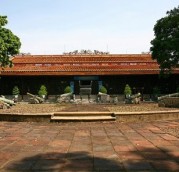Much of the Imperial City was built during the reign of Emperor Minh Mang. His tomb is located at the juncture of two tributaries of the Perfume River surrounded by rolling hills. It is said that it took 13 years to find an appropriate burial site for the Emperor and upon arrival it's not hard to see why this location was chosen. Set within an exquisitely landscaped garden it is a tranquil and idyllic place. The site is considered one of the best examples of Nguyen Dynasty architecture and artwork.

The Tomb is 12km form Hue, on Cam Ke mount, near Bang Lang fork, on the west bank of the Perfume River.
In September 1840, the construction of the tomb began. In January 1841, while the work was implemented Minh Mang was sick and passed away.
Emperor Thieu Tri, his successor to the throne, continue this task according to his father’s plans. Emperor Minh Mang's corpse was buried in Buu Thanh on August 20th of 1841. The construction was fully completed in 1843.
Minh Mang's tomb is a standard architectural complex consisting of 40 constructions (palaces, temples, pavilions, etc.) designed on an symmetric axis running from Dai Hong gate to the foot of La Thanh (Surrounding Wall) behind the Emperor's tomb.
Within the area enclosed by La Thanh Wall (1,750 m), there is a complex of palaces, pavilions and buildings symmetrically arranged along the 700m Holy Axis or Than Dao, which stretches from Dai Hong Mon (Great Red Gate) to the La Thanh wall, beyond the Emperor’s grave. The buildings are intermingled with lotus ponds and pine-covered hills. |




